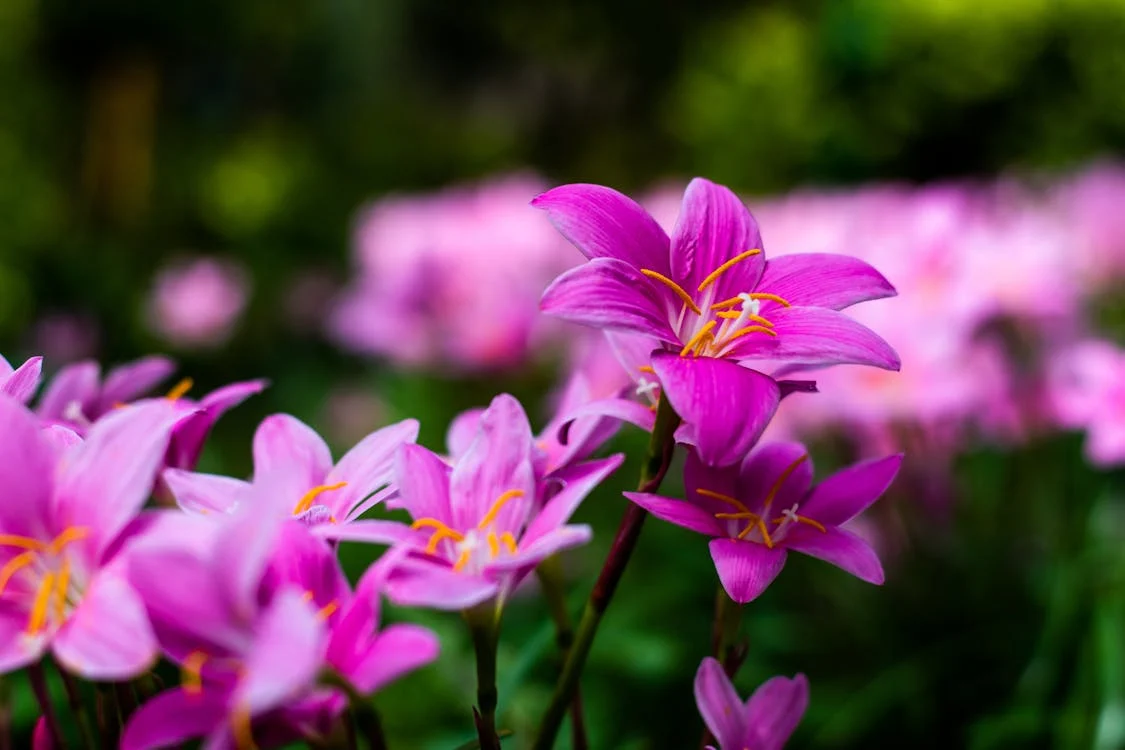masai-land-rover.com – Rain lilies, also known by their scientific name Zephyranthes, are a group of perennial flowers that offer a vibrant and delightful display of color after rainfall. These charming flowers are native to the Americas and are often seen blooming after a heavy rainstorm, which is how they earned their common name. With their delicate, funnel-shaped blooms in shades of white, pink, yellow, or red, rain lilies bring joy and beauty to any garden. Whether used as a border plant, in a wildflower garden, or even in containers, rain lilies add a pop of color and life to landscapes, especially in warmer climates.
Physical Characteristics
Rain lilies are small, bulbous plants that typically grow between 6 to 12 inches (15 to 30 cm) tall. They feature slender, grass-like leaves that form dense clumps from which the flowers emerge. The flowers themselves are usually trumpet-shaped and grow on long, thin stems that rise above the foliage. Each bloom lasts only a day or two, but the plant produces numerous flowers over the course of its blooming season, creating a striking display.
The colors of rain lilies vary depending on the species and cultivar. Common colors include soft pink, white, yellow, and even deep red or orange. Many species of rain lilies, such as Zephyranthes grandiflora, bloom in response to rainfall, which is a unique and delightful feature of these plants. The blooms may appear suddenly after a summer downpour, creating a burst of color that is often fleeting but breathtaking. The flowers’ delicate petals are usually star-shaped with a narrow throat, giving them an elegant and refined appearance.
Growing Conditions
Rain lilies thrive in warm climates and are well-suited to USDA hardiness zones 7 to 10. These plants prefer full sun to partial shade and grow best in well-drained soil. They can tolerate a range of soil types, including sandy, loamy, or even slightly clayey soils, as long as drainage is adequate. Rain lilies also perform well in garden beds, borders, and even containers, making them a versatile addition to any garden.
One of the defining features of rain lilies is their ability to bloom after rainfall, which makes them ideal for gardens that receive periodic rainfall. These plants prefer moderate moisture but are also relatively drought-tolerant once established. During the hot summer months, a deep watering will encourage blooming, but the plants do not require constant moisture. They thrive in well-drained soil, which helps prevent root rot, and can tolerate brief dry spells. Once established, rain lilies are low-maintenance and require little care beyond occasional watering during dry periods.
Uses in Gardening and Landscaping
Rain lilies are a fantastic choice for gardens that experience sporadic rainfall or for gardeners who want to add a touch of seasonal beauty. They are ideal for planting in flower beds, along borders, or in rock gardens, where their elegant blooms can stand out among other plants. Due to their small size, rain lilies are also great for container gardening, where they can be placed on patios, balconies, or porches for a colorful display.
Rain lilies work well in mass plantings, where they can create a stunning, colorful carpet of flowers after each rainfall. Their grass-like foliage complements other flowering plants, such as daylilies, coneflowers, and lavender, and they can be used as a filler plant between larger plants or shrubs. Their versatility makes them a great choice for naturalized areas, wildflower gardens, or even as a ground cover in sunny, well-drained areas.
Caring for Rain Lilies
Rain lilies are relatively easy to grow and maintain. Here are some tips for caring for them:
- Watering: Rain lilies should be watered regularly during dry spells but do not require constant moisture. The plants are most likely to bloom after rainfall or a deep watering, so maintaining moderate moisture levels is key. Be careful not to overwater, as excess moisture can lead to root rot.
- Sunlight: Provide full sun for optimal blooming. However, rain lilies can also tolerate partial shade, especially in hotter climates where afternoon shade may be beneficial.
- Soil: Plant rain lilies in well-drained soil. They can adapt to a variety of soil types, but good drainage is essential to prevent waterlogging and root rot.
- Fertilizing: Feed rain lilies with a balanced, slow-release fertilizer in the spring to encourage strong growth and flowering. Avoid excessive fertilization, as this can lead to lush foliage at the expense of blooms.
- Division: Rain lilies can be divided every few years to maintain their vigor. Dig up the bulbs after the foliage has died back and replant them in a new location. This helps prevent overcrowding and encourages healthy growth.
Ecological Benefits
Rain lilies are beneficial to local ecosystems, attracting pollinators such as bees, butterflies, and hummingbirds, which are drawn to their brightly colored blooms. These pollinators play a vital role in maintaining biodiversity and ensuring the health of surrounding plants. By planting rain lilies in your garden, you contribute to a healthier, more sustainable environment.
Additionally, rain lilies help to stabilize soil and prevent erosion in areas with well-drained soils. Their bulbs form an underground network that can help hold soil in place, making them valuable for erosion control in garden beds and borders.
Conclusion
Rain lilies are a delightful and low-maintenance addition to any garden, offering vibrant color and beauty after each rainfall. With their easy care requirements, wide range of colors, and ability to bloom with the changing weather, rain lilies are perfect for adding a touch of seasonal charm to landscapes. Whether grown in flower beds, containers, or wildflower meadows, these cheerful flowers are sure to brighten up any garden and bring a sense of joy and wonder after the rain.
